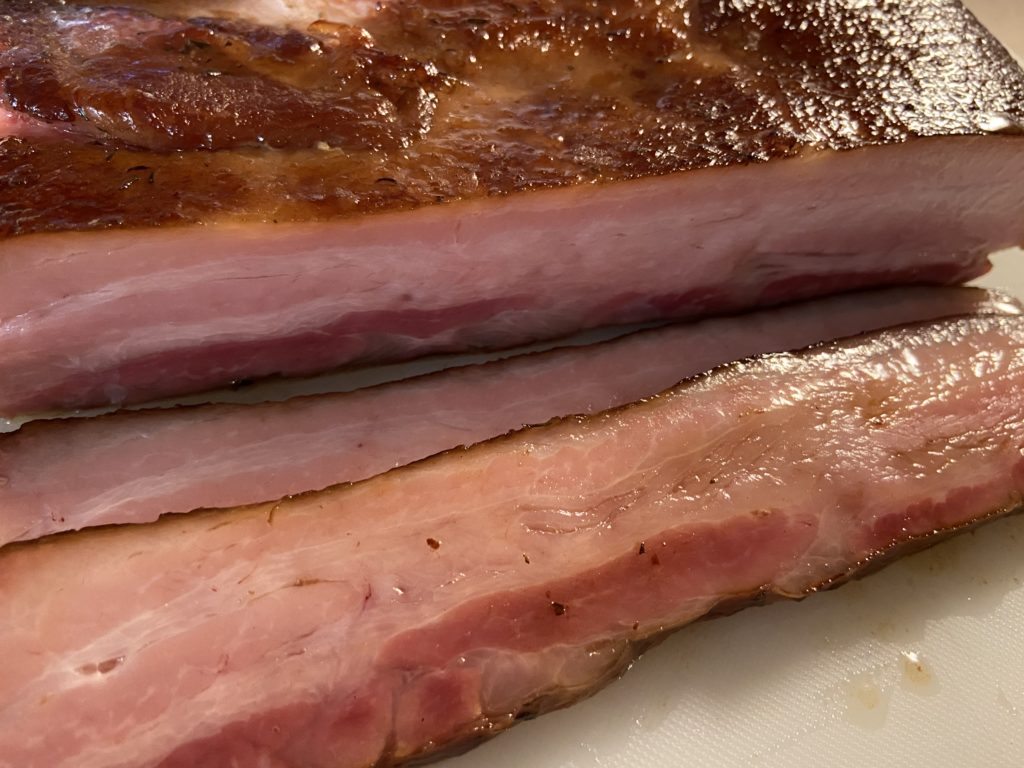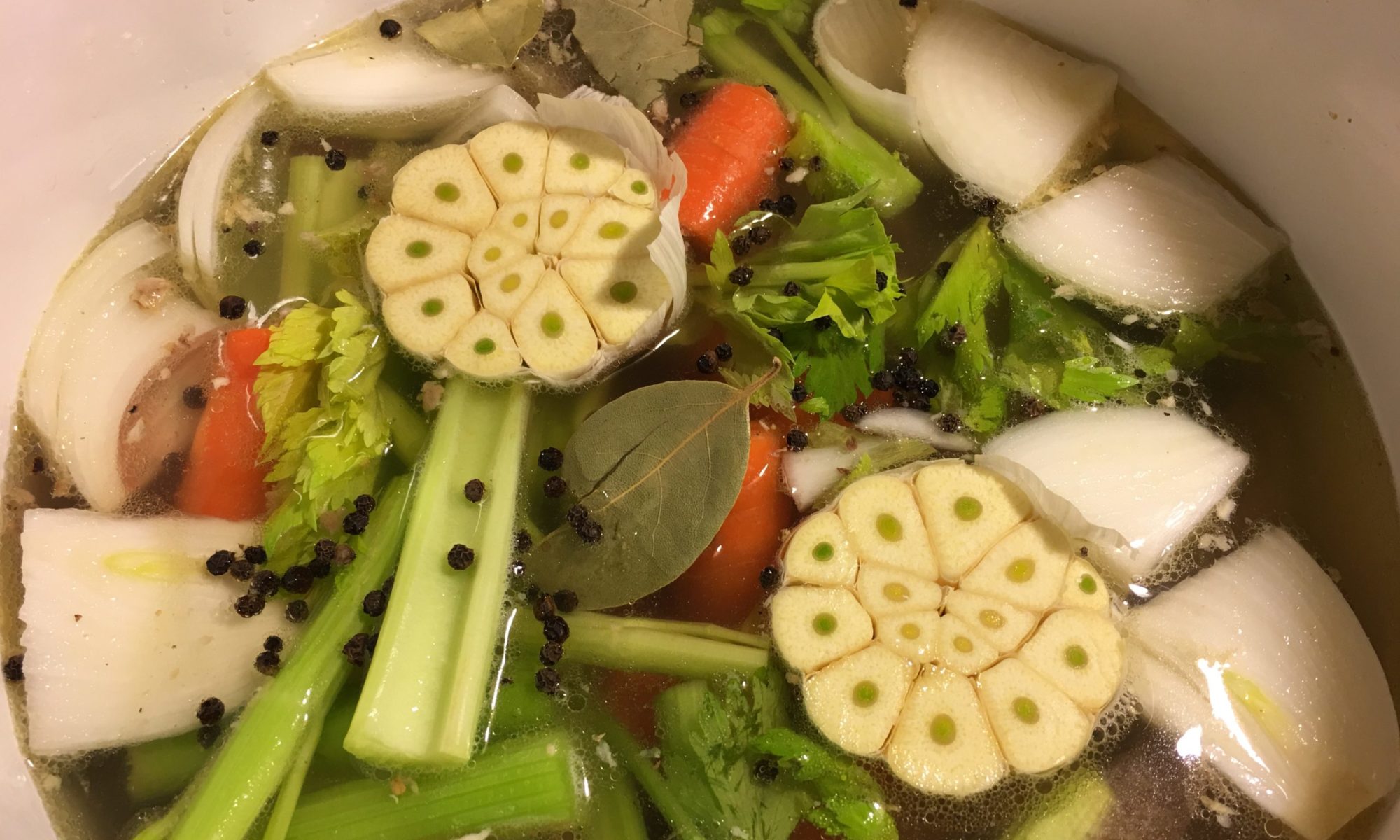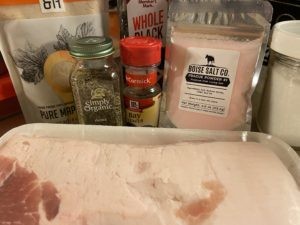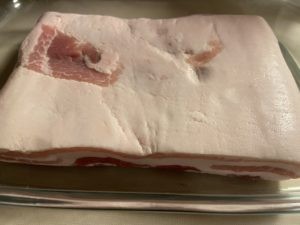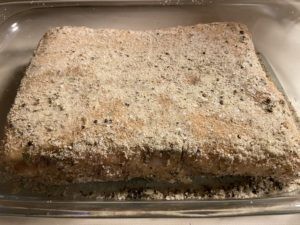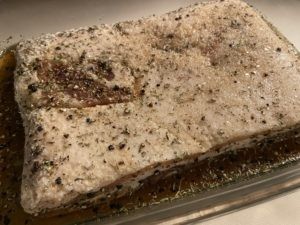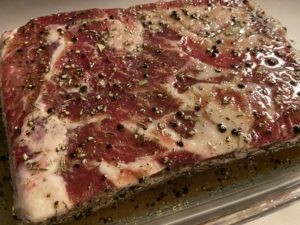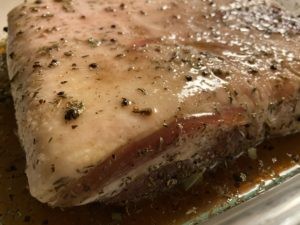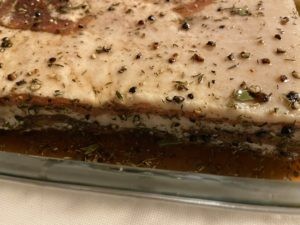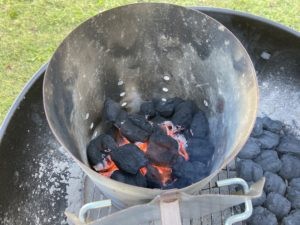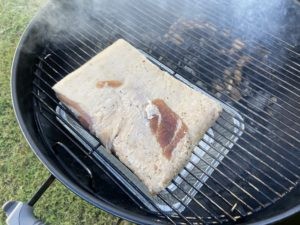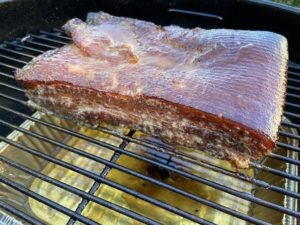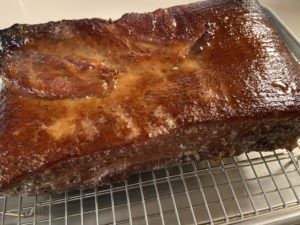Ingredients
1 cup maple sugar
¼ cup Morton kosher salt
1 Tbsp peppercorns, cracked
2 tsp minced fresh thyme
¾ tsp pink curing salt
1 bay leaf, crumbled
1 (4-pound) pork belly, skin removed
4 medium hickory wood chunks, soaked in water for 1 hour
Directions
Combine sugar, salt, peppercorns, thyme, pink salt, and bay leaf in small bowl. Place pork belly in 13 by 9-inch glass baking dish and rub all sides and edges of pork belly with dry cure mixture. Cover dish tightly with plastic wrap and refrigerate until pork feels firm yet still pliable, 7 to 10 days, flipping meat every other day.
Thoroughly rinse pork with cold water and pat dry with paper towels.
Open bottom vent of smoker completely (to use a charcoal grill, see directions below). Arrange 1½ quarts unlit charcoal briquettes in center of smoker in even layer. Light large chimney starter three-quarters filled with charcoal briquettes (4½ quarts). When top coals are partially covered with ash, pour evenly over unlit coals. Place wood chunks on coals. Assemble smoker and fill water pan with water according to manufacturer’s instructions. Cover smoker and open lid vent completely. Heat smoker until hot and wood chunks are smoking, about 5 minutes.
Clean and oil smoking grate. Place pork belly meat side down in center of smoker. Cover (positioning lid vent over pork) and smoke until pork registers 150 degrees, 1½ to 2 hours.
Remove bacon from smoker and let cool to room temperature before slicing. Bacon can be wrapped tightly with plastic and refrigerated for up to 1 month or frozen for up to 2 months.
TO MAKE BACON ON A CHARCOAL GRILL: Open bottom vent of charcoal grill halfway and place large disposable roasting pan filled with 2 cups water on 1 side of grill. Arrange 1 quart unlit charcoal briquettes evenly over half of grill opposite roasting pan. Light large chimney starter one-third filled with charcoal briquettes (2 quarts). When top coals are partially covered with ash, pour evenly over unlit coals. Place wood chunks on coals. Set cooking grate in place, cover, and open lid vent halfway. Heat grill until hot and wood chunks are smoking, about 5 minutes. Clean and oil cooking grate. Place pork belly meat side down on cooler side of grill over water-filled pan and smoke as directed.
When you buy pork belly, the skin is usually left intact; you’ll need to remove it before proceeding. Start by separating the skin from the fat layer at one corner. Then, holding the knife almost parallel to the belly with one hand and the corner of skin with your other hand, make short horizontal cuts, pulling the skin back as you move across the belly. Take your time to ensure you leave as much of the thick layer of fat intact as possible. After all, fat absorbs flavor, so once you’ve cured and smoked the belly, you’ll be glad you left it all on there.
Curing the pork belly adds flavor and firms it up. I use a 13 by 9-inch dish, though a 2-gallon zipper-lock bag would work. I like maple sugar as my rub’s base; it gives the bacon a sweetness that perfectly complements the meatiness. The pink salt, which contains nitrites, prevents bacterial growth, boosts flavor, and preserves the meat’s red color. I could have tweaked my recipe to work without it, but it’s a smart safety measure, plus bacon made without pink salt just doesn’t taste as good. When rubbing on the dry cure, be sure to cover the sides and edges of the belly well.
Once you’ve coated your pork belly with the rub, cover the dish with plastic wrap and put it in the fridge. I flip it every other day, which ensures that as the belly releases liquid, the cure is evenly distributed and stays in direct contact with the meat. After seven to 10 days, the belly will be fully cured, at which point it will feel firm to the touch yet still pliable. After a quick rinse under cold water to remove any excess cure (it will be too salty if you don’t), it’s ready to smoke.
While smoking the belly, you want to maintain a moderate heat level. Too much heat and all the fat will render from the bacon; not enough and the bacon won’t cook through. By placing lit coals on top of unlit charcoal in your smoker, you can achieve the appropriate temperature (200 to 225 degrees) without having to replenish coals halfway through cooking. The water pan in the smoker also helps to temper the heat. For making bacon on a charcoal grill, I create an indirect heat by arranging unlit and lit coals on one half of the grill and a water pan on the other half.
Next, place the wood chunks on top of the charcoal. It takes about five minutes for them to be ready; just let the initial burst of smoke cook off before putting the meat in the smoker since the first few seconds of smoke can impart a bitter flavor. I find it best to place the pork belly fat side up to allow the rendered fat to baste the meat. If you’re using a charcoal grill, make sure to place the belly on the cooler side of grill, over the water-filled pan.
After about 1½ hours in the smoker, the bacon will register 150 degrees and have a deep amber hue. At this point you might be tempted to just stand and stare at how amazing your homemade bacon looks, but I suggest removing it instead. It tastes even better than it looks.
Since the bacon is smoked until it registers 150 degrees, it is fully cooked once you take it out of the smoker. Frying it is just an extra step and not completely necessary. Sometimes I slice it paper-thin and serve it cold, garnished with some Green Tomato Chutney. When served cold like this, the smoke flavor is much more forward. Pan-frying the bacon tames its smokiness. Whichever way you slice it, this bacon is delicious.
NOTE: Curing salt goes by many names, including DQ Curing Salt and Insta Cure #1, but it’s most commonly labeled pink salt. Curing salt is important for curing meats because it contains nitrites, which prevent bacterial growth, boost the meaty flavor, and preserve the red color. You can find curing salt in specialty food stores or through online retailers. (Do not substitute Morton’s Tender Quick or Insta Cure #2.)
